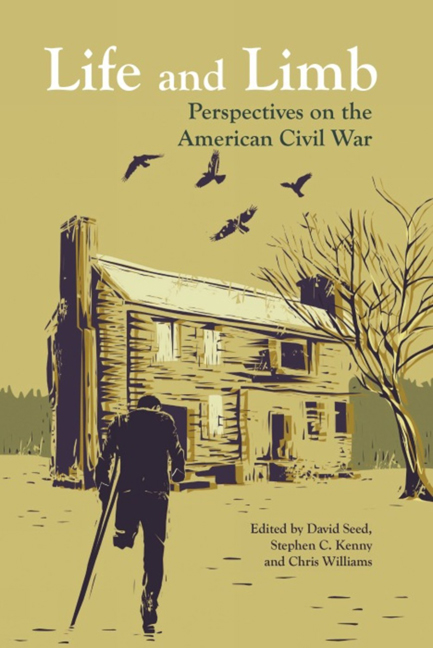Book contents
- Frontmatter
- Contents
- List of Illustrations
- Acknowledgements
- Introduction: Civil War Voices and Views
- MEDICAL AND SURGICAL MEMOIRS
- ACCOUNTS OF NURSING
- MEDICAL FACILITIES AND PATHOLOGY
- PHOTOGRAPHY
- AMPUTATIONS AND PROSTHETIC LIMBS
- ‘The Invalid Corps’ (song)
- The Case of Napoleon Perkins
- The First Amputee: ‘Record of Services’
- Testimonial Letter
- The Salem Leg (brochure)
- Testimony of Wearers (The Salem Leg: Under the Patronage of the United States Government for the Use of the Army and the Navy)
- The Human Wheel: ‘The Human Wheel, Its Spokes and Felloes’
- ‘The Case of George Dedlow’
- ‘Phantom Limbs’
- IN THE FIELD OF BATTLE
- POST-WAR NARRATIVES
- Contributors
- Select Bibliography
- Index
- Plates
‘Phantom Limbs’
from AMPUTATIONS AND PROSTHETIC LIMBS
- Frontmatter
- Contents
- List of Illustrations
- Acknowledgements
- Introduction: Civil War Voices and Views
- MEDICAL AND SURGICAL MEMOIRS
- ACCOUNTS OF NURSING
- MEDICAL FACILITIES AND PATHOLOGY
- PHOTOGRAPHY
- AMPUTATIONS AND PROSTHETIC LIMBS
- ‘The Invalid Corps’ (song)
- The Case of Napoleon Perkins
- The First Amputee: ‘Record of Services’
- Testimonial Letter
- The Salem Leg (brochure)
- Testimony of Wearers (The Salem Leg: Under the Patronage of the United States Government for the Use of the Army and the Navy)
- The Human Wheel: ‘The Human Wheel, Its Spokes and Felloes’
- ‘The Case of George Dedlow’
- ‘Phantom Limbs’
- IN THE FIELD OF BATTLE
- POST-WAR NARRATIVES
- Contributors
- Select Bibliography
- Index
- Plates
Summary
The following is from Silas Weir Mitchell's ‘Phantom Limbs,’ Lippincott's Magazine of Popular Literature and Science 8 (1871), pp. 563–69. Mitchell estimated that the war had produced at least 15,000 amputees, now known to be a gross under-estimate.
Mitchell extended his studies into everyday life with Wear and Tear or, Hints for the Overworked (1871), developing a rest cure which was taken by Charlotte Perkins Gilman (dramatized in her 1892 story ‘The Yellow Wallpaper’), Edith Wharton, and later by Virginia Woolf. In his 1884 novel, In War Time, Mitchell describes the Filbert Street Hospital in Philadelphia. For commentary on his career, see Nancy Cervetti, S. Weir Mitchell, 1829–1914: Philadelphia's Literary Physician (University Park, PA: Pennsylvania University Press, 2012).
Many persons feel the lost limb as existing the moment they awaken from the merciful stupor of the ether given to destroy the torments of the knife; others come slowly to this consciousness in days or weeks, and when the wound has healed; but, as a rule, the more sound and serviceable the stump, especially if an artificial limb be worn, the more likely is the man to feel faintly the presence of the shorn member. Sometimes a blow on the stump will reawaken such consciousness, or, as happened in one case, a reamputation higher up the limb will summon it anew into seeming existence.
In many, the limb may be recalled to the man by irritating the nerves in its stump. Every doctor knows that when any part of a nerve is excited by the excited by a pinch, a tap or by electricity – which is an altogether harmless means – the pain, if it be a nerve of feeling, is felt as if it were really caused in the part to which the nerve finally passes.
[...]
On one occasion the shoulder was thus electrized three inches above the point where the arm had been cut off. For two years the man had ceased to be conscious of the limb. As the current passed, although ignorant of its possible effects, he started up, crying aloud, ‘Oh, the hand, the hand!’ and trying to seize it with the living grasp of the sound fingers. No resurrection of the dead, no answer of a summoned spirit, could have been more startling. As the current was broken the lost part faded again, only to be recalled by the same means.
- Type
- Chapter
- Information
- Life and LimbPerspectives on the American Civil War, pp. 147 - 148Publisher: Liverpool University PressPrint publication year: 2015



